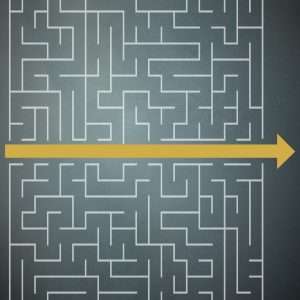And Who Was Dave Elman?
Dave Elman profoundly influenced the field of hypnotherapy and was a pioneer of medical hypnosis in America and around the world.

David Kopelman (a name he later shortened to Dave Elman for show biz!) was born in a Park River, North Dakota on May 6, 1900. His family later moved to Fargo, ND, and he grew up there.
He would eventually lead a life that included being a professional comedian, Vaudeville performer, musician, radio personality, author and finally, medical hypnosis pioneer.
Before his fascinating and varied adult life, however, David was deeply affected by hypnosis as a young boy. His father, Jake, was a bit of a student of hypnosis. So when Jake was suffering from a lot of pain due to cancer, he called on a hypnotist for help.
Dave watched his father receive relief from his cancer pain via hypnosis and was forever changed by the experience.
Hypnosis became an integral part of Dave's life, and he would go on to study hypnosis first as a hobby, and then a profession. Including hypnosis in his stage performances, and eventually making an impact by teaching medical professionals how to use hypnosis as an effective tool in their medical and dental practices, Dave Elman's impact on the practice of medical hypnosis cannot be overstated.
The Life and Times of Dave Elman
Yes, as an adult Dave taught medical hypnosis and his work influenced many hypnosis professionals around the world.
But, before that...
As a teenager, David Kopelman quit high school and “ran away to join the circus”.
Well, not the circus, exactly - but he did go on to become a Vaudeville performer when he was just 15 years old. In fact, in the book "Oi! Oi! I'm Leffing!", his family let's us know that the reason he shortened his name from David Kopelman to Dave Elman was so his name would fit on the billboards!
Performing a variety of characters and music on stage, Dave was also able to share his love of hypnosis with his audiences, and was billed as “The World’s Youngest and Fastest Hypnotist”.
However, Dave’s significant influence on the field of hypnotherapy, and medical hypnosis specifically, didn’t really come to fruition until after WWII. He didn't start teaching hypnosis to medical professionals until 1949, and his iconic book, "Hypnotherapy", wasn't published until 1964.
Did You Know This About Dave Elman???
As a radio host during World War II, Dave Elman helped raise money for War Bonds with his radio program, “War Bond Auction” (later renamed “Victory Auction”).
He also helped bring a German spy ring out of the dark, and helped the FBI as a “part-time counter-spy”.

Dave Elman At the Forefront of Medical Hypnosis
After his life had calmed down a bit, Elman found himself sitting with a friend of his who was a doctor, talking about hypnosis. During all of his adventures in life, Dave had continued to study hypnosis. His first exposure to hypnosis had been the pain relief his father experienced when Dave was young, so he knew hypnosis could be an effective tool for medical professionals.
His doctor friend was describing a medical problem that Dave knew could be solved easily with the proper application of hypnosis. So he went back to the doctor’s office with his friend and showed him. Soon, he began teaching doctors and dentists how to use hypnosis in their medical practices.
You can read more details about Dave Elman's life, as well as getting a good chuckle, in "Oi! Oi! I'm Leffing!", which you can find on the Elman Institute's website.
Dave Elman “Hypnotherapy”
Widely recognized as one of the pioneers of modern hypnotherapy, Dave Elman’s techniques and approaches are still used by hypnotists around the world. While Elman focused primarily on teaching medical hypnosis, as evidenced in the book “Hypnotherapy”, hypnotists and hypnotherapists of all types can learn a lot from his work.

“Hypnotherapy” (originally with the title “Findings in Hypnosis”), was published in 1964, and has stayed relevant and useful to hypnosis students to this day. You can find a copy through the Elman Institute.
Elman is also known for his work in developing hypnotherapy training programs and for his efforts to promote the use of medical hypnosis.
Elmanian Hypnosis
Dave Elman is credited with developing a form of hypnosis known as "Elmanian hypnosis," which is characterized by the use of rapid induction techniques and hypnoanalysis.
The Elman Induction techniques are designed to bring about a hypnotic state in the subject quickly and efficiently. Elman's approach to hypnosis emphasized the importance of using language and suggestion to help the subject enter into a hypnotic state and to make positive changes in their behavior or thinking.
Elmanian hypnosis is often used in medical and therapeutic settings to help people overcome a range of issues, including addiction, anxiety, and phobias.
What Is the Dave Elman Induction?
The Elman Induction is a process in which a hypnotist utilizes specific phases that a hypnotic subject goes through to take them into a somnambulistic trance. It incorporates specific techniques for inducing hypnosis, often very rapidly.
As the process takes the hypnosis subject through very effective steps that lead to trance, it also allows for the hypnotist to utilize judgement in staying within a phase until the goal of that phase is achieved. For instance, eye catalepsy is an easy to achieve and perceive indication of trance.
The Elman Induction provides the opportunity to direct the subject to close and relax the eyes. It allows the subject and the hypnotist to observe this hypnotic phenomenon, and stay with it until eye catalepsy is achieved.
What Makes The Elman Induction Different?

There are many hypnotic inductions out there, but the process for inducing trance that was developed and taught by Dave Elman is much more than an induction script.
It is a very focused, process driven hypnotic induction. By directing the subject to voluntarily and readily produce hypnotic phenomena, Elman discovered a direct and rapid path into trance.
No tricks.
Nothing fancy.
Just ask, and you shall receive.
Then, rinse and repeat, until somnambulism is achieved.
This allows the Elman Induction to be a fantastic tool for helping hypnotic subjects learn how to go into trance. By instructing subjects to engage in the induction process, rather than being passive and just waiting for the hypnotist to "put" them in trance, Elman's process encourages the subject's cooperation. Agreement and cooperation of the subject is an important element in achieving hypnosis.
While some hypnotic inductions wander around and sometimes rely on time to bore the subject into trance, or relax, relax, relax and “hope” to elicit hypnotic phenomena eventually, the Elman Induction cuts right to the chase and leads the subject into trance with purpose.
Who Is The Elman Induction Good For?

Even though the Elman Induction is billed as, well, an induction, it is really more of a process. Each phase of the process is aimed at specific goals, and if the hypnotist using this process understands this, it becomes a flexible guide and process, rather than what some might consider a scripted induction.
Even the most seasoned professional hypnotherapist can make good use of the Elman Induction process. However, it is particularly good for new hypnotherapists. By following this process driven induction, the new hypnotherapist can be clear about the hypnotic phenomena needed and employed in the induction.
Because Elman's induction process is so direct, it prevents a new hypnotherapist from getting lost in their induction, or worrying about whether they have elicited enough or the proper hypnotic responses. It also allows for deepening, and ensuring the sought after trance state.
Once could argue that using the Elman Induction as a teaching tool would be extremely effective. By looking at each phase of the process, and learning to stay within that phase until the phase goal is achieved, a hypnotist could skillfully allow for flexibility within each phase. This would allow the hypnotist to tailor the process to the individual subject before them.
A Brief Look At The Elman Induction
The process of the Elman Induction is fairly simple and is easily broken down into five phases:
Phase 1: Establishing Credibility
Credibility is extremely important in hypnosis, but it is more than just the hypnosis subject knowing that the hypnotist is a Certified Hypnotist/Hypnotherapist.
This first phase of the Elman Induction is one that should be part of every induction, as it helps the subject establish both credibility and "compliance". It also establishes rapport between the hypnotist and the subject.
The important part here is credibility and compliance - how it is achieved could be flexible, although the Elman Induction has a very effective method.
Most importantly, this phase helps the subject believe.
Larry Elman (Dave Elman's son), writes about establishing credibility in his book, "Blueprint of the Dave Elman Induction". He specifically addresses 3 types or levels of credibility:
- "Belief by the subject that the hypnotist knows what they are doing."
- "Belief by the subject that the process can work."
- "Belief by the subject that they are capable of doing what is suggested."
This initial phase of the process allows the subject the opportunity to establish belief, and start “practicing” what the hypnotist suggests and demonstrates.
Phase 2: Eye Catalepsy, or "Catalepsy of a Small Group of Muscles"
Hypnotic catalepsy involves the voluntary or involuntary tension (or resistance to movement) in muscles and is one well known indication of trance. The Elman Induction process elicits this response by directly telling the subject to “relax the muscles around your eyes so much, that as long as you hold onto that relaxation, your eye muscles just won’t work.”
This phase helps to bypass the critical factor, narrow their mind's focus, and further establish belief in both the process and their own effectiveness within that process.
Phase 3: Fractionation
Fractionation in hypnosis is a way to deepen a subject's trance by having the subject repeat a process, doubling or tripling (or some variable) their relaxation or trance with each repetition. The Elman Induction employs fractionation early in the process, by having them open and close their eyes repeatedly, “doubling” their relaxation each time.
Fractionation can be employed at almost any step of the induction process, whenever the hypnotist wants to increase relaxation/trance. Or even as a method of teaching the subject HOW to increase their relaxation, or go deeper into trance.
Phase 4: Testing and Deepening
The goal of this phase is to deepen the trance, test for level of trance, and further convince the subject that they are going into a deep trance.
In the Elman induction, after the eye catalepsy and fractionation, the hypnotist spends some time explaining that physical relaxation and mental relaxation can BOTH be produced, and by testing both physical and mental relaxation.
First, physical relaxation is tested with a simple arm drop, developing catalepsy of a larger muscle group. The common practice with the Elman Induction is for the hypnotist to hold the subject’s hand up (usually the subject will be seated in a chair), and letting it drop back onto the arm of the chair.
The hypnotist may have demonstrated this prior to inducing trance, so the subject knows what to expect. The subject is instructed to just let the arm or hand go, let it be heavy and totally relaxed and just
“flop like a wet dishcloth.”
This is repeated, deepening the relaxation (and trance) until the the subject has successfully demonstrated their physical relaxation through arm catalepsy.
Phase 5: Suggested Amnesia
Now, the “final” stage of deepening in the Elman Induction is eliciting hypnotic amnesia. The subject is instructed to count backwards from 100, out loud, deepening their mental relaxation with each number, until they have:
"relaxed their mind so much...
that there won’t be any more numbers left to say."
With each number, the hypnotist gives deepening and encouraging suggestions, helping to “erase” the numbers from the subject’s mind. When the subject stops counting, the hypnotist tests for suggested amnesia by asking “All gone?”, being careful to avoid using the word “numbers” (or letters if using the alphabet instead of numbers).
This is important because using the word “numbers” could cause the numbers to appear again.
There are many free examples of the Elman Induction available on the internet, often with slightly varying perspectives.
Both of the following links will lead you to very good but slightly different discussions of the Elman Induction:
Mike Mandel’s Discussion of the Elman Induction
Keith Livingston’s Discussion of the Elman Induction
However, to truly master the induction process and understand the foundational elements of the induction, Larry Elman's book "Blueprint of the Dave Elman Induction" is a very good guide, and can be purchased in either hard copy or electronic form (for immediate download).
Certification in Elmanian Hypnosis
Specializing in Elmanian Hypnosis means something in the world of hypnotherapy.
If you choose to include specializing in Elmanian Hypnosis in your credentials, be sure to let your future client’s know what that means for them, and how it can make their hypnotherapy sessions even more effective. Hopefully this guide has given you an idea of how you can include useful information on your website or in your initial conversation with your client.
Some hypnotherapy programs, including some IHA Approved Courses, offer Elmanian Hypnosis courses, or offer a specialization in Elmanian Hypnosis.
Members of the International Hypnosis Association can add the “Specialist in Elmanian Hypnosis” credential to their profile upon completion of an appropriate course at no extra charge.


